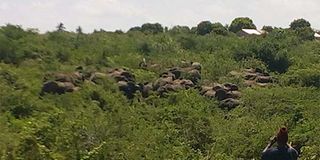Human-wildlife conflict worsens in Kwale as drought persists

Some of the 52 elephants that strayed from the Mwalungaje Elephant Sanctuary on October 20, 2018, casuing panic in Kiteje and Mbuguni villages in Kwale County. PHOTO | FADHILI FREDRICK | NATION MEDIA GROUP
When the night falls, the cover of darkness brings with it terror for most villagers in Lungalunga constituency, Kwale County.
The inhabitants have lived with this terror for a long time and become used to it, but their patience is running out.
Until recently, villagers whose settlements were on the fringes of the vast Tsavo West National Park were patient as elephants escaping the harsh drought found their way to their homes and farms.
The most affected are Kwa Nyanje, Kigingiri, Mwakinyavu, Chuini and Jamvini villages.
The beasts descend on settlements, targeting villagers and their crops.
Benson Mutinda, a cash-crop farmer in Mwakanyavu, is counting losses after jumbos invaded his farm, destroying his tomatoes, kale and sorghum.
Since July, he said, the animals have been visiting the farms at night, feeding and stepping on crops.
“The situation is getting worse by the day. For instance, our children have to be escorted to school after 9am, when we have confirmed that there is no elephant on the move,” said Mr Mutinda.
The herds of elephants target water pans, the only available water sources in the affected areas, creating a perennial shortage of water for domestic use.
"We are now fighting over the resource with the animals. Once they land at the water pan, they leave when the water is finished," said Joseph Mwema, a resident of Kasemeni.
There was nothing much they could do but threaten to take the law into their own hands as the danger posed by the wildlife freely roaming the neighbourhood was alarming.
The villagers had prepared bows and arrows to attack the elephants.
But killing wildlife in Kenya is punishable by law.
This forced the Kenya Wildlife Service (KWS) to promise to deploy more wardens in hotspot areas to curb human-wildlife conflict.
The move came after residents threatened to execute any elephants that invaded their farms and homes. They said at least seven people had been killed by the jumbos since last year.
It is the same case for Wamasa, Tata, Vigurungani and Rorogi villages in the semi-arid Kinango constituency. Farmers said elephants invade their farms daily. The jumbos break fences to get to crops and water pans.
Several elephants are escaping harsh drought conditions in some parts of Tsavo National Park and northern Tanzania to search for pasture and water in residential areas, said KWS Kwale Senior Warden Jacob Orale.
"The animals come to the villages in search of food and water. However, we have to learn to coexist with them … even as KWS is trying to direct them back to the parks,” Mr Orale told the Nation.
It was agreed at a meeting held with locals in Kwa Nyanje village that the KWS deploy more wardens in hotspot areas to curb the attacks, said Lungalunga MP Mangale Chiforomodo.
“Two camps will be set up within Kasemeni village, while more officers will be deployed in the affected areas. This will reduce the conflict between locals and wildlife to ensure each other’s safety,” Mr Chiforomodo said.
At least three people have been killed by elephants in the last two months in the border constituency and the hotspot areas are Chuini, Kwa Nyanje and Jamvini villages, said Lungalunga Deputy County Commissioner Joseph Sawe.
“The remains of the body of a man were found on his farm after an elephant attack. There was also a man who was injured and ended up dying in hospital. A child was also killed,” Mr Sawe said.
He said the elephants move in herds of six, eight or even 10 while terrorising residents in different villages and eating their crops as they search for water.
Locals were urged to report to the police or local administration whenever they see elephants but not attempt to kill them.
Climate change, Mr Orale said, was the main reason behind the clashes. He urged residents to be patient as they await the rainy season.
This year alone, Kenya has lost 179 elephants and 200 Somali giraffes to drought, according to Tourism and Wildlife Cabinet Secretary Najib Balala.
Meanwhile, Mr Orale asked locals who are victims of the wildlife attacks to apply for compensation.
They need reports from the local warden, police and hospital and take them to KWS offices to get a compensation form, he said.
Their application will then be considered by the community wildlife compensation committee.
Though human-wildlife conflicts are on the rise, few people have been compensated over the years, with victims waiting a long time to be paid.
Residents of Lungalunga have complained that compensation forms are not available.
In July last year, Mr Balala said the government had a backlog of compensation claims amounting to Sh14 billion.
Compensation is key because it determines whether residents and wildlife will have a good relationship and whether locals will participate in conservation programmes.
Kwale County's proximity to Shimba Hills and Tsavo national parks puts the area at high risk of wildlife attacks. Animals in the parks are also vulnerable to poaching as they use parts of the county as migratory channels.
In September last year, two children were mauled to death by hyenas in Silaloni, Kinango constituency. The beasts were suspected to have come from Tsavo National Park in search of food.





